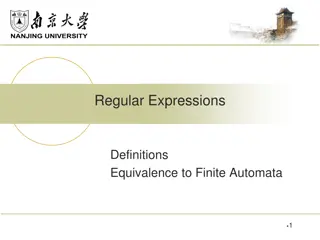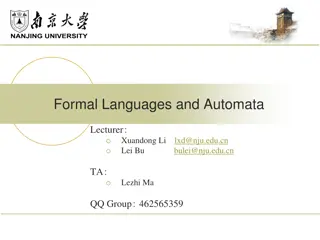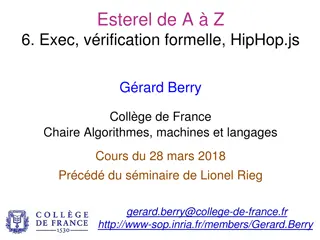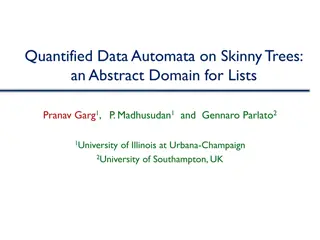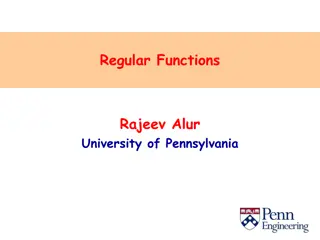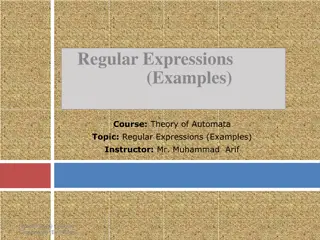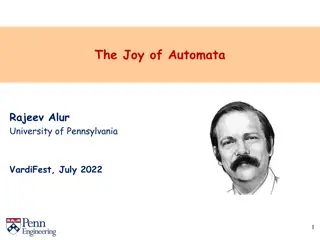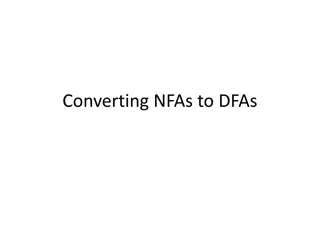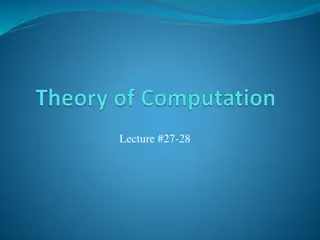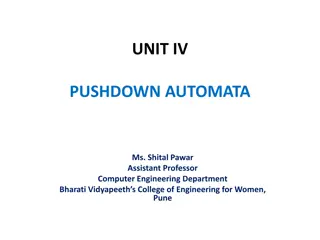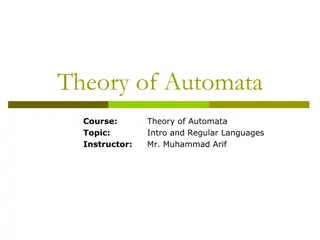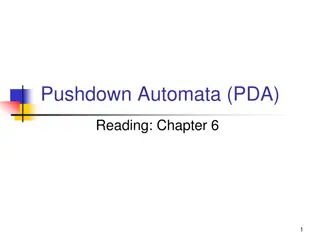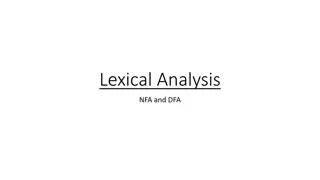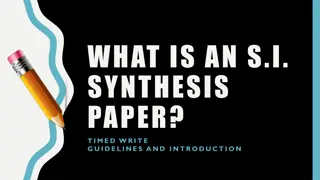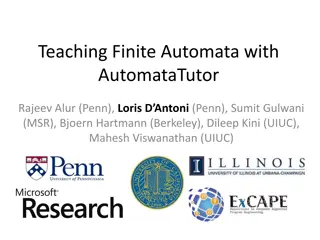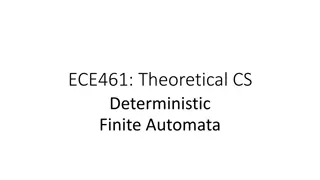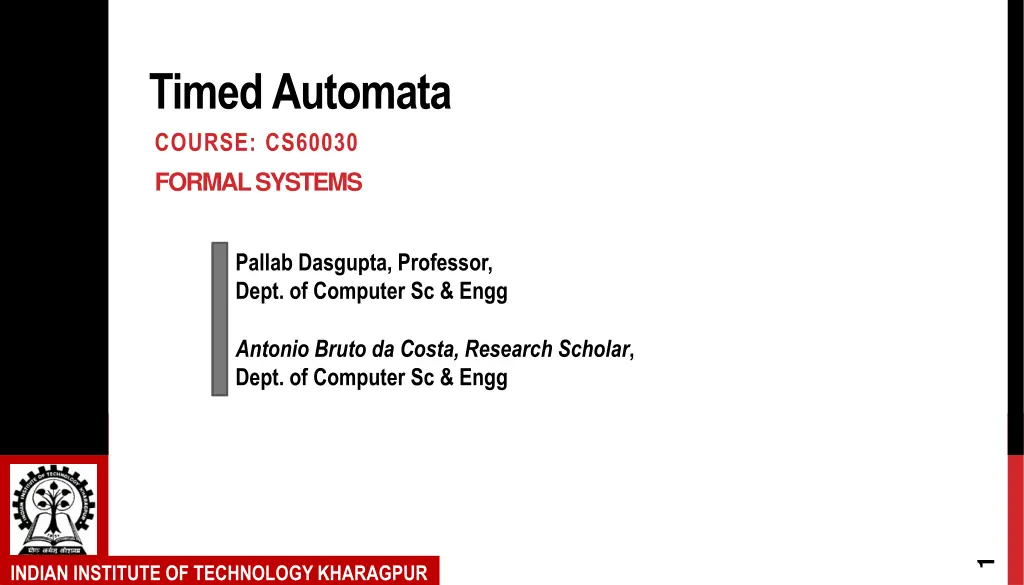
Timed Automata Course at IIT Kharagpur: Formal Systems Overview
Explore the Timed Automata Course at IIT Kharagpur, covering topics like Simple Light Control, Mouse Clicks, Model Checking, Systems and Automata, Examples of Models, and Timed Automata informally. Learn about formal systems, state machines, real-valued clocks, and transition systems represented as finite automata, pushdown automata, and more.
Download Presentation

Please find below an Image/Link to download the presentation.
The content on the website is provided AS IS for your information and personal use only. It may not be sold, licensed, or shared on other websites without obtaining consent from the author. If you encounter any issues during the download, it is possible that the publisher has removed the file from their server.
You are allowed to download the files provided on this website for personal or commercial use, subject to the condition that they are used lawfully. All files are the property of their respective owners.
The content on the website is provided AS IS for your information and personal use only. It may not be sold, licensed, or shared on other websites without obtaining consent from the author.
E N D
Presentation Transcript
Timed Automata COURSE: CS60030 FORMAL SYSTEMS Pallab Dasgupta, Professor, Dept. of Computer Sc & Engg Antonio Bruto da Costa, Research Scholar, Dept. of Computer Sc & Engg 1 INDIAN INSTITUTE OF TECHNOLOGY KHARAGPUR
Simple Light Control Press Press Press Off Light Bright Press WANT: if press is issued twice quickly then the light will get brighter; otherwise the light is turned off. Some of these slides are adapted from Prof. Rajeev Alur s presentations
Simple Light Control Press x:=0 Press x<=3 Press Off Light Bright x>3 Press Solution: Add a real-valued clock x Adding continuous variables to state machines
Mouse Clicks DoubleClick! Press? Press? Single Press Double Press Inputs : a? Outputs : b! Off SingleClick! WANT: if press is issued twice quickly then double click; otherwise single click.
Mouse Clicks x==0 DoubleClick! x:=0 Press? x:=0 Press? Single Press Double Press Off x<=0.5 x>0.5 SingleClick! Solution: Add a real-valued clock x Adding continuous variables to state machines
Model Checking ? Does satisfy SYSTEM SPECIFICATION ? ? start model-checker model formula 6 INDIAN INSTITUTE OF TECHNOLOGY KHARAGPUR
Systems and Automata Systems under analysis are modeled and represented as transition systems: Finite automata Pushdown automata Program graphs Timed automata Hybrid automata Petri Nets Channel Systems Message Sequence Charts 7 INDIAN INSTITUTE OF TECHNOLOGY KHARAGPUR
Examples of Models A numerical code door lock: A vending machine: A timed - switch: 8 INDIAN INSTITUTE OF TECHNOLOGY KHARAGPUR
Timed Automata - informally Timed automaton: Finite automaton enriched with clocks 9 INDIAN INSTITUTE OF TECHNOLOGY KHARAGPUR
Timed Automata - informally Timed automaton: Finite automaton enriched with clocks Transitions: equipped with guards 10 INDIAN INSTITUTE OF TECHNOLOGY KHARAGPUR
Timed Automata - informally Timed automaton: Finite automaton enriched with clocks Transitions: equipped with guards and sets of reset clocks 11 INDIAN INSTITUTE OF TECHNOLOGY KHARAGPUR
Timed Automaton - Model Structure Timed Automata: a timed automaton is a tuple ? = ?,??,????,?,?,? where, L L is a finite set of locations, L L0 0 L L , , is the initial set of locations L Lacc L , L , is the set of accepting locations ? is the finite alphabet ? is the finite set of clocks ? ? ? ? ?? ? , is the set of edges ? = { ? ? | ? ?,? } is the set of guards, { <, , =, >, } acc 12 INDIAN INSTITUTE OF TECHNOLOGY KHARAGPUR
Timed Automaton - Semantics ? , assigns to each clock a clock-value. Valuation: ? + State: (?,?) ? + ?, is composed of a valuation and a location. Transitions between states of ?: ? (? , ?+ ?) ? (? , ? ) Delay transitions: (?,?) Discrete transitions: (?,?) If ?,?,?,?,? ? with ? ? and ? ? = ? ?? ? ? ?? ?????? ? ? = ? ? 13 INDIAN INSTITUTE OF TECHNOLOGY KHARAGPUR
Runs, Sequences, Words, Languages ?1 (?0 , ?0+?1) ?1 (?1 , ?1) ?2 (?1 , ?1+?2) ?2 ?? (?? , ??) Run of A A: (?0, ?0) or simply ?1,?1 (?1 , ?1) ?2,?2 ??,?? (?? , ??) (?0, ?0) Time Sequence: t = ? = ?? 1 ? ? is a finite non-decreasing sequence over +. Timed Word: w = ( ,?) = ??,?? 1 ? ? where ?? and ? is a time sequence. Accepted Timed Word: A timed word w = ?1,?1 ?2,?2 ??,?? is accepted in A A, if there is a run ?1,?1 ( (?1 , , ?1) ) ?2,?2 ??+1,??+1 (??+1, , ??+1) ) with ?0 L0, ?? Lacc and ?? = ?<??? = ( = (?0, , ?0) ) Accepted timed language: ?(A) (A) = w w accepted by A} 14 INDIAN INSTITUTE OF TECHNOLOGY KHARAGPUR
An Example We omit: Guards when they are identity Reset set when empty w = (b, 0.1)(b, 0.3)(a, 1.3)(b, 1.5)(a, 1.5)(b, 2.5) is an accepted timed word An accepting run for w is 0.1,? ( (?0,0.1,0) ) 0.2,? ( (?0,0.3,0) ) 1,? ( (?0,1.3,1) ) 0.2,? ( (?0,1.5,0) ) 0,? ( (?1,0,0) ) 1,? ( (?2, ,1,1) ) ( (?0,0,0) ) 15 INDIAN INSTITUTE OF TECHNOLOGY KHARAGPUR
More Examples ?(A) = a,t1 a,t2, , a,tk ? < ?,?? ti= 1} Does there exist an accepted timed word containing action b? 16 INDIAN INSTITUTE OF TECHNOLOGY KHARAGPUR
Adding Invariants (Henzinger et al, 1992) n Clocks: x, y x<=5 Transitions: ( n , x=2.4 , y=3.1415 ) wait(3.2) x<=5 & y>3 Location Invariants a wait(1.1) x := 0 ( n , x=3.5 , y=4.2415 ) ( n , x=2.4 , y=3.1415 ) m y<=10 g4 g1 Invariants ensure progress!! g3 g2 17
Another Example: Model of a small jobshop Must rest for at least 5 mins Cant work for more than 60 minutes x := 0 y := 0 start y := 0 x 5 Cant rest for more than 10 mins x 60 y 4 Work hit Rest x 10 y 1 x := 0 x 40 At most one nail every minute done At least one nail every 4 minutes Must work for at least 40 minutes 18
And one more: Rail Gate Crossing approach x >= 1 up lower y := 0 far near y <= 1 x <= 5 x := 0 y >= 1 exit x := 0 enter x > 2 raise y := 0 y <= 2 in down Train Gate approach z := 0 z <= 3 Controller lower raise exit z := 0 z <= 1 19
And one more: Rail Gate Crossing approach x >= 1 up lower y := 0 far near y <= 1 x <= 5 x := 0 y >= 1 exit x := 0 enter x > 2 raise y := 0 y <= 2 in down Train Gate approach z := 0 z <= 3 Controller lower raise exit z := 0 z <= 1 20 time
And one more: Rail Gate Crossing approach x >= 1 up lower y := 0 far near y <= 1 x <= 5 x := 0 y >= 1 exit x := 0 enter x > 2 raise y := 0 y <= 2 in down Train Gate approach z := 0 z <= 3 Controller lower raise exit z := 0 z <= 1 approach 21 time z <= 3
And one more: Rail Gate Crossing approach x >= 1 up lower y := 0 far near y <= 1 x <= 5 x := 0 y >= 1 exit x := 0 enter x > 2 raise y := 0 y <= 2 in down Train Gate approach z := 0 z <= 3 Controller lower raise exit z := 0 z <= 1 approach lower 22 time z <= 3 y <= 1
And one more: Rail Gate Crossing approach x >= 1 up lower y := 0 far near y <= 1 x <= 5 x := 0 y >= 1 exit x := 0 enter x > 2 raise y := 0 y <= 2 in down Train Gate approach z := 0 z <= 3 Controller lower raise exit z := 0 z <= 1 x = 2.1 y = 0.9 z = 2.1 approach lower enter 23 time x > 2 x <= 5
Time Convergence, Timelocks, Zenoness Not all paths in a timed automaton represent realistic behaviours. Examples Three essential phenomena: Time Convergence Timelock Zenoness 24 INDIAN INSTITUTE OF TECHNOLOGY KHARAGPUR
Time Divergence A path is time divergent if the sum of the delays over this path is infinite. Time convergence - a path for which the sum of the delays are bounded by some natural numbers. Time over this path will never increase above a constant. Represents unrealistic behaviours, cannot be avoided in the theory. For analysis ignore time convergent paths and only consider time divergent ones. ?1,?1 ( (?1 , , ?1) ) ExecTime( ) = ?=? ?2,?2 Execution time for an execution : ( (?0, , ?0) ) with ?0 L0is given as ?? Time divergence: An infinite path fragment is time divergent if and only if ExecTime( ) = . Otherwise the path fragment is time convergent. 25 INDIAN INSTITUTE OF TECHNOLOGY KHARAGPUR
Timelocks For a state in a timed-automaton, there must be some way for time to progress. If no way is possible, then has a timelock. Let Pathsdiv( ) be the set of time-divergent paths starting in . A state s contains a timelock iff Pathsdiv( ) = A timed automaton is timelock-free iff none of its reachable states contains a timelock. A timelock is a modeling flaw should be avoided. 26 INDIAN INSTITUTE OF TECHNOLOGY KHARAGPUR
Zenoness An infinite path fragment is zeno if and only if it is time-convergent and infinitely many discrete actions are executed within . Zeno paths represent non-realizable behaviour since their execution would require infinitely fast processors. Thus zeno paths are modelling flows and should be avoided. To check whether a timed automaton is non-zeno is algorithmically difficult. Instead, sufficient conditions are considered that are simple to check, e.g., by static analysis. 27 INDIAN INSTITUTE OF TECHNOLOGY KHARAGPUR
Verification System modeled as a product of timed automata Verification problem reduced to reachability or to temporal logic model checking Applications Real-time controllers Asynchronous timed circuits Scheduling Distributed timing-based algorithms
Variants of timed automata Many variants of TA exist: Diagonal constraints: Guards are conjunctions of constraints of the form x c and x y c. Additive clock constraints: constraints of the form x c and x + y c. Epsilon transitions: Actions from the alphabet ? Updatable timed automata: Clocks updates of the form: x: c and x: y + c 29 INDIAN INSTITUTE OF TECHNOLOGY KHARAGPUR
Timed Automata and Reachability Abstractions The REGION GRAPH: (constraint set C) Set of Regions: ?, the set of valuations) is a set of regions (for C) if the following all ? (a finite partition of + hold: 1. For every g C and for every R ? : R ? OR ? R = 2. For all R,R ?, if there exists v R and t with v + t R then for every v R there exists a t with v + t R 3. For all R,R ?, for every Y ? if R[Y 0] 0] R , then R[Y 0] 0] R . 30 INDIAN INSTITUTE OF TECHNOLOGY KHARAGPUR
Region Graphs Set of Standard Regions Let M be the maximum constant in ?. The following equivalence relation yields the set of standard regions: v ?v if for every x,y ? v(x) > M v (x) > M v(x) M ( v(x) = v (x) ) and ({v(x)} = 0 {v (x)} = 0) (v(x) M and v(y) M) ( {v(x)} {v(y)} {v (x)} {v (y)} ) 31 INDIAN INSTITUTE OF TECHNOLOGY KHARAGPUR
Standard Regions (what do the rules mean?) 2 Clocks = 2 dimensions The partition is compatible with constraints, time elapsing and resets. v ?v if for every x,y ? v(x) > M v (x) > M v(x) M ( v(x) = v (x) ) and ({v(x)} = 0 {v (x)} = 0) (v(x) M and v(y) M) ( {v(x)} {v(y)} {v (x)} {v (y)} ) 32 INDIAN INSTITUTE OF TECHNOLOGY KHARAGPUR
Operations on Regions For two clocks, the (bounded) regions have the following shapes: R[Y 0 R is a time-successor of R if there exists v R , v R, t +with v = v + t 0] ] denotes the region obtained from R by resetting clocks in Y ?. ? ? ????? (x=0,y=0) (0<x=y<1) (0<x<1,y=0) ????? ????? ????? (0<y<1=x) (0<y<x<1) ????? (y=1<x<2) (1<x<2,0<y<1,{x}<{y}) ? ? (x=0,y=1) 33 INDIAN INSTITUTE OF TECHNOLOGY KHARAGPUR
Region Automaton From a timed automaton ? we build a finite region automaton (?) as follows: States: ? ? Initial Set: L L0 0 ? Final Set : L Lacc Transitions: (?,?) acc ? ? (? , ? ) if there exists ?,?,?? in ?, ? R time-successor of R with R ?and R = R [Y 0 0] ]. 34 INDIAN INSTITUTE OF TECHNOLOGY KHARAGPUR
Example Timed Automaton Region Automaton 35 INDIAN INSTITUTE OF TECHNOLOGY KHARAGPUR
A Logic for Timed Automata Timed CTL TCTL = CTL + Time Syntax: = ? ? ? ?? ? ?[ ] p AP, automic propositions z D , formula clocks ? constraints over formula clocks and automata clocks z in - freeze operator introduces a new formula clock z ? | ? - As in C No [ E X ] 36 INDIAN INSTITUTE OF TECHNOLOGY KHARAGPUR
Derived Operators A [ U 7 ] = z in A [( z 7) U ] ] Along any path, hold continuously until within 7 time units becomes valid. = z in EF [( z< 5) ] ] E F 5 ] There is a path on which the property becomes valid within 5 time units. 37 INDIAN INSTITUTE OF TECHNOLOGY KHARAGPUR
Consider the Light Switch AG( ) x y AG( AF ) on off AG( AF ) on off 9 A U 2 off x A U 3 off x E U 3 off x A U 2 on x E U 2 on x 38 INDIAN INSTITUTE OF TECHNOLOGY KHARAGPUR
Timeliness Properties AG [send(m) AF<5 receive(m)] receive(m) always occurs within 5 time units after send(m) EG [send(m) AF=11 receive(m)] receive(m) may occur exactly 11 time units after send(m) AG [ AG=25 putbox] putbox occurs periodically (exactly) every 25 time units (note: other putbox s may occur in between) 39 INDIAN INSTITUTE OF TECHNOLOGY KHARAGPUR
Moving forward from Timed Automata Regular - Finite (Deterministic/NonDeterministic Finite Automata) Locations = States, Memory is finite states are finite. Discrete actions only Transition Systems Finite location systems : possibly infinite states (with variables) Discrete actions only Timed Automata Finite location systems timers : possibly infinite states (When would a TA have finite states?) Discrete and Delay actions Hybrid Automata Finite location systems beyond timers : possibly infinite states Discrete actions and Custom activities 40 INDIAN INSTITUTE OF TECHNOLOGY KHARAGPUR

